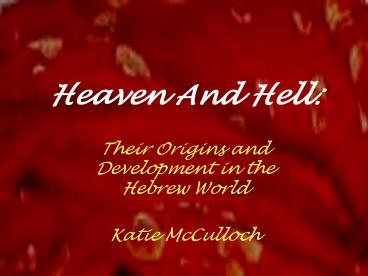Heaven And Hell: - PowerPoint PPT Presentation
1 / 16
Title:
Heaven And Hell:
Description:
165BCE) all the souls are resurrected and are separated into groups of ... From their ideas, good souls would ascend upward and individuals would continue their ... – PowerPoint PPT presentation
Number of Views:1122
Avg rating:5.0/5.0
Title: Heaven And Hell:
1
Heaven And Hell
- Their Origins and Development in the Hebrew
World - Katie McCulloch
2
Ancient Semitic Belief
- Most Semitic peoples were polytheistic, believing
in more than one god. - Men lived on earth, while above them reigned the
sky gods and below them was Sheol, where infernal
gods dwelled. - Men could appeal to the sky gods or to their
ancestors in Sheol, but those in Sheol were cut
off from the sky gods.
3
Schematic Drawings of Semitic World
4
Sheol for the Hebrews
- The Hebrews were strongly influenced by the
Semitic ideas. - Sheol was the resting place where the dead joined
their ancestors. - Good and evil alike went to Sheol after dying.
- Sheol was silent and dark, and the shades in
Sheol were incapable of praising God.
5
Yahwehs Rewards/Punishments
- Most of the early Hebrew belief was based on
Deuteromic law. - Yahweh expressed his approval (or lack of) in
this world. - Disobedience led to invasions, plagues, and
ultimately death. - Faithfulness resulted in being blessed with many
cattle, children, fields, and respect.
6
Sheol Lessens
- This type of belief minimized the idea of any
type of life after death. - When the Hebrews were conquered by the Assyrians,
they tried to worship only one god. - With the end of the Judean monarchy by the
Babylonians in 586 BCE, the dream of a restored
Israel begins to grow.
7
Dissatisfaction Grows
- Because of equality in death, many Hebrews feel
that the situation is unfair. - Those who are good and poor have the same fate as
the rich and evil. - This dissatisfaction is expressed in the musings
of Job, Psalms 47 and 73, and Ecclesiastes.
8
Sheol Evolves
- In the later Old Testament books there is a shift
to the belief of immortality. - Sheol becomes divided, so that the good shades
are kept apart from the bad ones. - Gehenna is where the Hebrews who broke the
Covenant burn perpetually. The good souls rest
in comfort and peace.
9
The Development of Hell
- The regions of hell and descriptions begin with
Isaiah, Ezekiel, and Jeremiah. - In Daniel (ca. 165BCE) all the souls are
resurrected and are separated into groups of
everlasting life and everlasting contempt. - The misery of the Syrian and Roman oppressions
also resulted in apocalyptic literature.
10
Bodily Resurrection?!
- Babylonian captivity gave the Hebrews another
reason to focus on the next world. - Ezekiel took the ideas of Zoroaster and suggested
that when the end comes, the dead would rise to
join the living in a restored world. - Once the dead are resurrected, they would have to
face judgment.
11
The Development of Heaven
- The ideas of Greeks such as Plato, Cicero,
Plutarch, and Vergil influenced the Hebrews
ideal Heaven. - From their ideas, good souls would ascend upward
and individuals would continue their existence. - Others thought that Jerusalem restored would
descend from above and the living and dead would
exist there together.
12
New Testament Sects
- The Sadducees maintained the belief that Yahwehs
rewards came in this life and that there was
nothing to come after death. - The Pharisees were ritual-oriented, purists, and
accepted the idea of resurrection. - The Essenes held an individualistic perspective
on the afterlife. They saw heaven as eternity in
a place like the Greeks Isle of the Blest.
13
New Testament Views
- Heaven was the only way that believers of Christ
could experience the divine fully. - Hell, according to Thayer, is not a doctrine of
endless punishment as Christ went there before
his resurrection. - Descriptions and explanations are few since most
Hebrews assumed the end times were at hand.
14
Since New Testament Times...
- Very little was stated explicitly by the Old and
New Testaments about the characteristics of
Heaven and Hell. - Since the end of New Testament times, speculation
on heaven and hell has been endless. - In Western literature and art, there have been
many different interpretations.
15
Bibliography
- Bernstein, Alan E. The Formation of Hell.
Ithaca Cornell U. Press, 1993. - McDannell, Colleen and Bernhard Lang. Heaven-A
History. London Yale U. Press, 1988. - Miller, Lisa, et al. Why We Need Heaven.
Newsweek 12 Aug. 2002 44-52. - Russell, Jeffrey Burton. The Devil Perceptions
of Evil From Antiquity to Primitive
Christianity. Ithaca Cornell U. Press, 1977.
16
Bibliography
- ---. A History of Heaven The Singing Silence.
Princeton Princeton U. Press, 1996. - Sheler, Jeffery L. Heaven in the Age of
Reason. U.S. News World Report 31 Mar 97
65-67. - Thayer, Thomas. The Biblical Doctrine of Hell.
The Origin and History of the Doctrine of
Endless Punishment. 1855. 21 Mar 2003
http//www.auburn.edu/allenkc/tbell. html.































